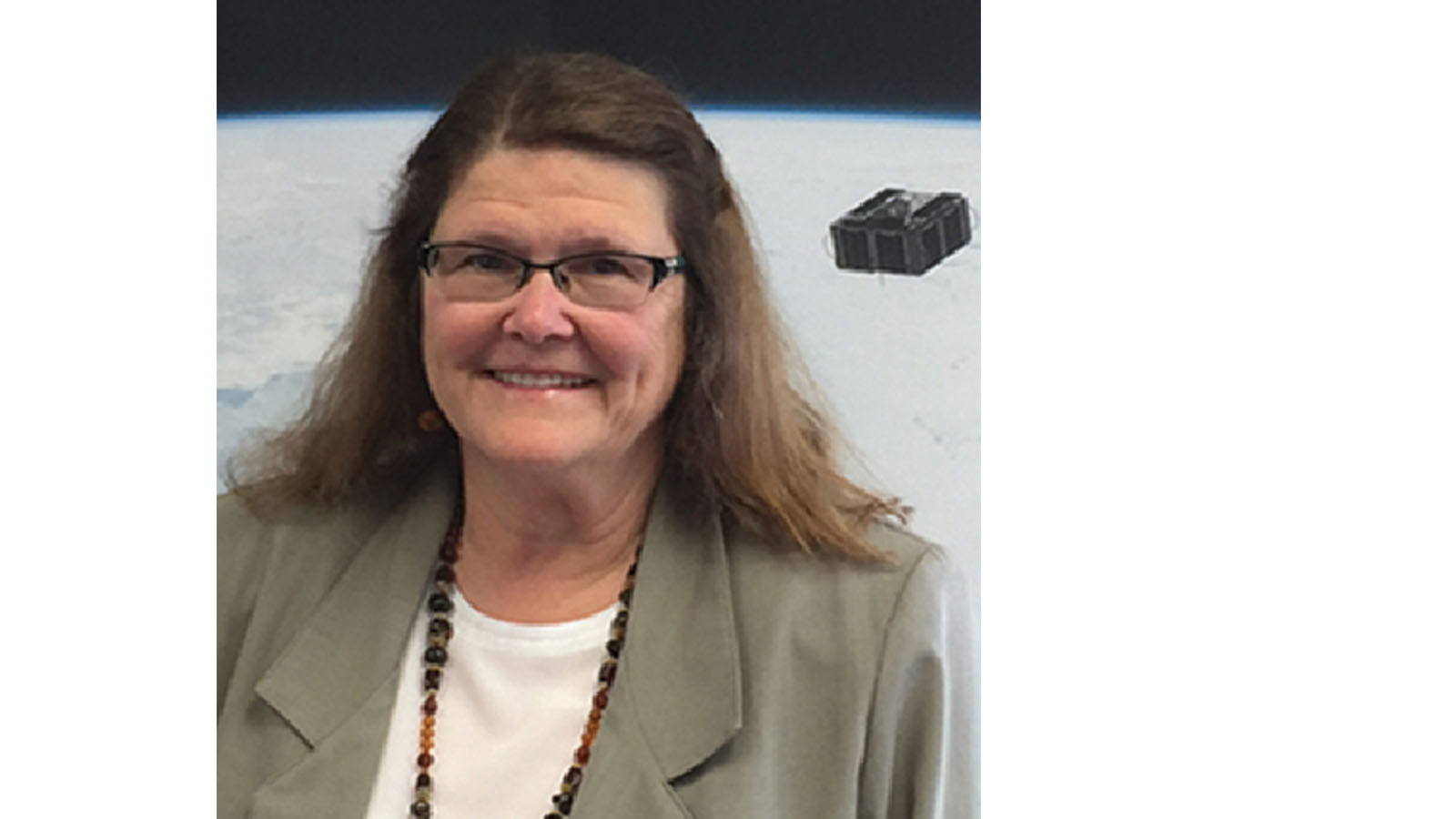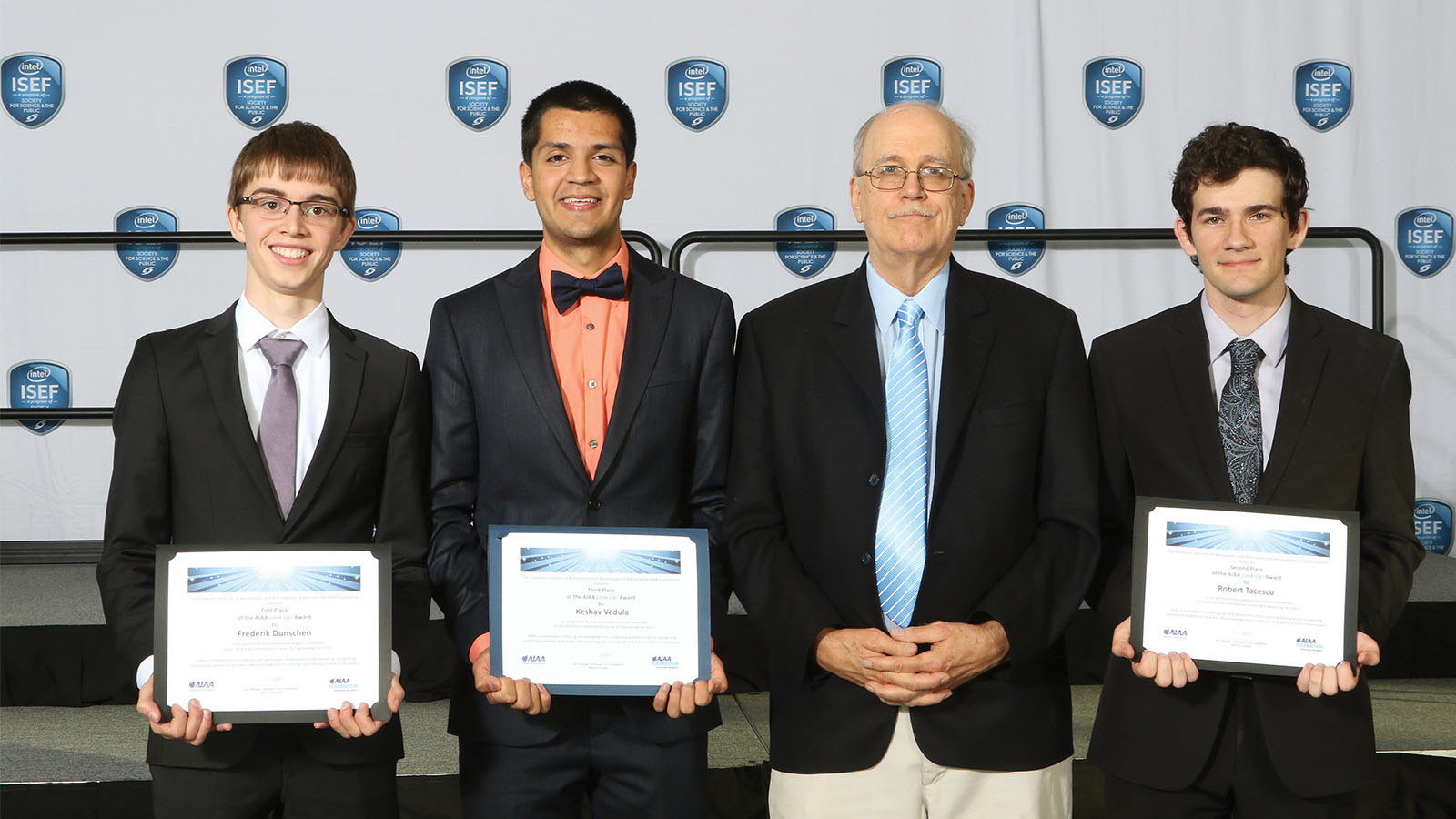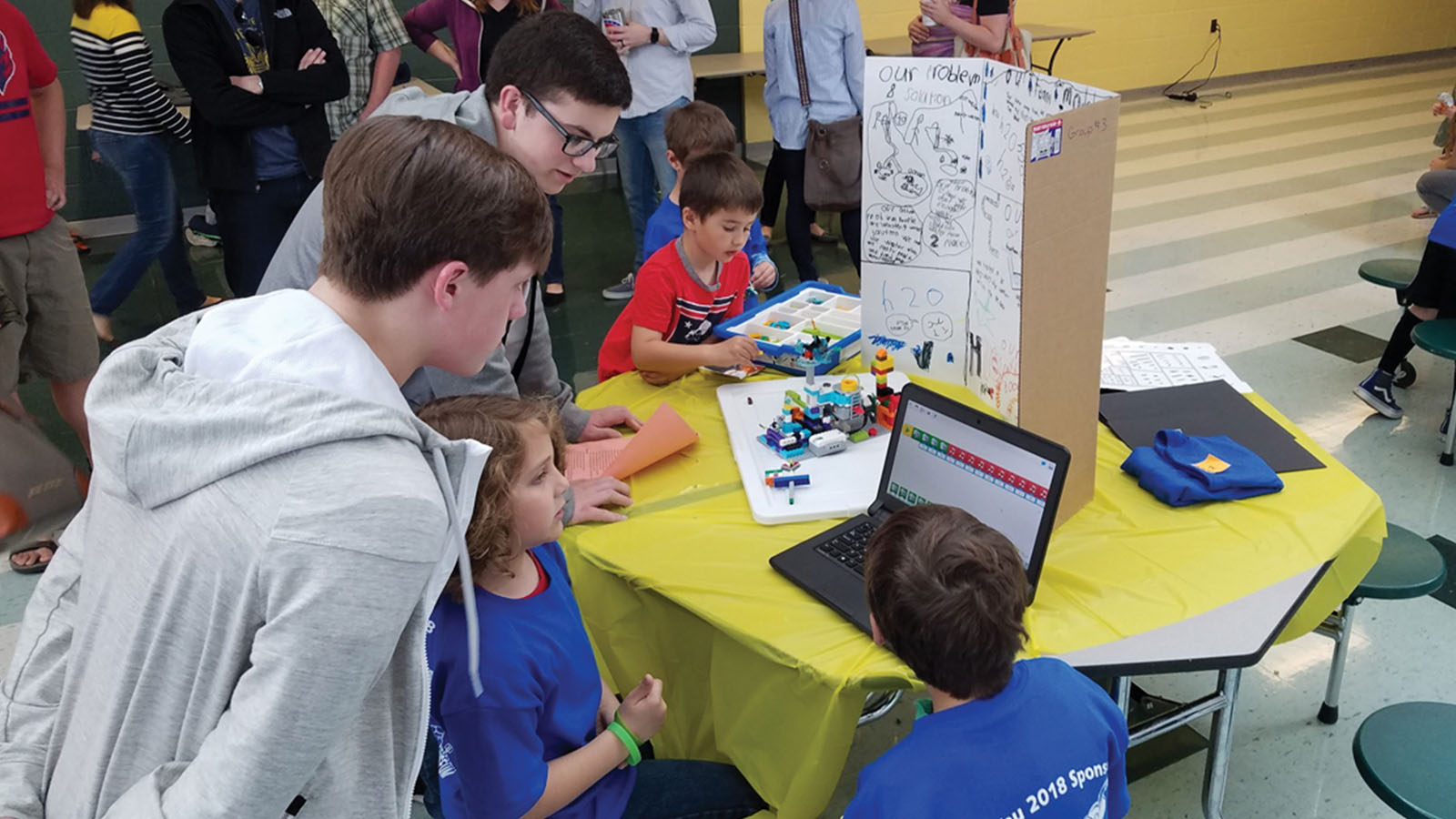Stay Up to Date
Submit your email address to receive the latest industry and Aerospace America news.

A Night to Remember: Jumping from Space 1.0 to Space 2.0
On 3 May, Professor Russell Boyce, director, University of New South Wales (UNSW) Canberra Space, hosted an “Intimate Cocktail Evening with the Stars of ‘Mission Control’” for a select group of Australian space academics, researchers, and professional, including members from the AIAA Sydney Section. The reception was organized to welcome Charlie Duke, former NASA Apollo 16 astronaut, and Gerry Griffin, former Apollo Mission Control Flight Director and former director, NASA Johnson Center, to Canberra. The special guests had arrived in Canberra as part of a national public-speaking tour of Australia sponsored by UNSW Canberra Space, as the major partner, and also supported by the Australian National University, represented by astrophysicist Dr. Lisa Harvey-Smith. Dr. Harvey-Smith facilitated an informative and entertaining panel discussion with Boyce, Griffin, and Duke. The discussion drew out highlights from their space mission training and operations experiences to inform and entertain the audience, jumping the audience from the Space 1.0 era of the NASA Apollo program to the Space 2.0 era small satellite program currently in progress at UNSW Canberra.

Helen L. Reed Wins 2018 Yvonne C. Brill Lectureship in Aerospace Engineering
AIAA Fellow Dr. Helen L. Reed, Regents Professor at Texas A&M University, is the recipient of the third Yvonne C. Brill Lectureship in Aerospace Engineering. Reed will present her lecture, “Student Design-Build-Fly Micro- and Nano-Satellites,” on 2 October, in conjunction with the National Academy of Engineering’s Annual Meeting in Washington, DC.
Notably, Dr. Reed has contributed to the discipline through her Satellite Design Programs: first at Arizona State University (ASUSat Lab) and then when her Lab moved with her to Texas A&M and became AggieSat Lab. She found effective ways to create interdisciplinary teams of undergraduate and graduate students, with industry and government affiliates, to engage in design-build-fly of operational small satellites while advancing new technologies that feed into national initiatives and learning industry practices within the university environment. Involving more than 1,000 students over the years, her team has launched four small satellites with the U.S. Air Force and NASA and partnered on other projects. Her students have joined space-oriented businesses and the national laboratories.
Dr. Reed is also an acknowledged national and international expert in laminar-to-turbulent transition. Her technical expertise is reflected in comprehensive pioneering contributions that integrate perceptive discernment of the fundamental physics of transitional flows with best-in-class simulations revealing key phenomenological details. Her work has not only provided essential fundamental insight into complex fluid dynamic processes, but also strongly influenced the development of aerospace systems. As lead computational person, Dr. Reed has teamed throughout her career with experimentalists to achieve a high degree of closure between theory and experiment. She has developed stability and transition tools that include linear stability theory, nonlinear parabolized stability equations, and direct numerical simulation of the Navier-Stokes equations. Her tools have supported and validated meaningful ground and flight experiments aimed at understanding the physics of transition and maturing drag reducing technologies.
Dr. Reed also has been honored with the 2018 AIAA Fluid Dynamics Award for “lifetime achievements in the fundamental understanding, modeling, and control of boundary-layer laminar-to-turbulent transition for aerospace vehicles from subsonic to hypersonic,” the 2016 American Society of Mechanical Engineers (ASME) Kate Gleason Award for “lifetime achievements in the fundamental understanding and control of boundary layer transition for high-efficiency aerospace vehicles, and in pioneering small satellite design and implementation,” and the 2007 J. Leland Atwood Award for important contributions to space systems engineering and space systems design education. She holds both the title of Presidential Professor for Teaching Excellence and the Edward “Pete” Aldridge ‘60 Professorship at Texas A&M. As well as being an AIAA Fellow, she is also a Fellow of ASME and the American Physical Society.
AIAA, with the participation and support of NAE, created the Yvonne C. Brill Lectureship in Aerospace Engineering to honor the memory of the late, pioneering rocket scientist, AIAA Honorary Fellow and NAE Member, Yvonne C. Brill. Brill was best known for developing a revolutionary propulsion system that remains the industry standard for geostationary satellite station-keeping.
SpaceOps Distinguished Service Medal Presented to Megan Scheidt
AIAA Managing Director of Products and Programs Megan Scheidt was presented with the SpaceOps Distinguished Service Medal at SpaceOps 2018 on 1 June in Marseille, France. She received the award: “In appreciation of over a decade of extraordinary contributions to the SpaceOps Organization, in particular shaping and optimizing the role of the newly established SpaceOps Secretariat.” AIAA has worked with the SpaceOps organization for 14 years and Scheidt served as the first SpaceOps Secretariat and then as AIAA manager directly responsible for support to SpaceOps.
New AIAA Foundation Daedalus 88 Scholarship Awarded
The inaugural AIAA Foundation Daedalus 88 Undergraduate Scholarship has been awarded to Samuel Zorek, who is studying for dual undergraduate degrees in Mechanical Engineering and Policy Studies at Rice University, Houston, TX.
The $10,000 scholarship is intended to promote and support student entrepreneurship in aerospace. It is funded through a generous donation by AIAA President John Langford, and will be awarded annually. In 1988, Langford and 39 fellow MIT students recreated the flight of Daedalus (the first reference in Western literature to man flying under his own initiative). The Daedalus Project ultimately set records in distance and for human-powered voyage with a 72-mile flight between the Greek islands of Crete and Santorini.
For the past two decades, the AIAA Foundation has awarded more than 750 scholarships and graduate awards to students. For more information, please go to the AIAA Foundation’s scholarship website, aiaa.org/Scholarships.
Paul Park Appointed as New Editor-In-Chief of Library of Flight
On 12 June 2018, AIAA President John Langford formally appointed Paul Park as the new editor-in-chief of the Library of Flight book series, succeeding Edward “Ned” Allen. The Library of Flight encompasses a wide variety of general-interest and reference books, including case studies. Subjects include the history and economics of aerospace as well as design, development, and management of aircraft and space programs.
Mr. Park currently is an adjunct faculty member at the University of Texas at Arlington in the Mechanical and Aerospace Engineering Department, following a 40-year career as an aerospace engineer employed by Boeing, General Dynamics/Lockheed, Bell Helicopter, and Orbital ATK. He holds engineering degrees from the University of Pennsylvania, Princeton University, and Stanford University.
An ad hoc search committee was appointed by the Publications Committee chair, John Daily, to evaluate applicants for the position. Mr. Park was chosen from among an exceptional field of candidates and will serve as the second editor-in-chief for the series, following the long and productive tenure of Dr. Allen, who served as the editor beginning in 2006 when the series was officially launched.
Mr. Park’s enduring interest in the history of aerospace and his commitment to education attracted him to the position. His goals for the series include encouraging more titles on recent aerospace developments, including topics such as computers in aerospace design, the space station, the Hubble telescope, and Mars rovers. He would also like to continue promoting works that cover the human history of aircraft and space program development that have always been part of the Library of Flight, including the leaders, personalities, conflicts, and key technical contributors to the industry.
Mr. Park is committed to the hard work of acquiring and developing manuscripts for the series. His long career in aerospace and his interest in educating the broader public about the industry will contribute to the continued success of the Library of Flight.

AIAA “Look Up!” Award
The AIAA “Look Up!” Award, presented at the Intel International Science and Engineering Fair (Intel ISEF), celebrates exceptional high school-level research to encourage further study in aerospace. Winners of the AIAA “Look Up!” Award receive a cash award and one year of AIAA student membership with access to all student programs. We congratulate the 2018 winners:
Frederik Dunschen (Friedensschule Munster, Munster, Germany) was awarded first place for Designing and Building a Continuously Spinning but Controllable Flying Object at this year’s Intel International Science and Engineering Fair, a program of Society for Science & the Public and the world’s largest international pre-college science competition.
Robert Gabriel Tacescu (Clovis North High School, Fresno, CA) won second place for his design, Safecopter: Developing a Collision Avoidance and Mapping System Based on an Array of Time-of-Flight 3D Cameras. The student designed a modular collision detection, avoidance, and mapping system that makes flying a multicopter in autonomous or tele-operated mode safe and responsive to the changing environment. The system used an array of time-of-flight 3D cameras for point cloud data with full 360° view.
Keshav Vedula (CREC Academy of Aerospace and Engineering, Windsor, CT) won third place for his research: Undulated Leading-Edge Airfoils in Low to Medium Reynolds Number Regime. The student studied airfoils with undulating leading-edges, which have been shown to improve stall characteristics in certain airflow regimes. His research project featured two NACA 2415 airfoils: a traditional design, and an experimental design with a sinusoidal leading-edge that mimics the tubercle protuberances on the leading-edge of humpback whale fins. Wind tunnel testing was conducted in the transitional regime with 3D-printed prototypes; coefficients of lift and drag were calculated for both airfoils at varying angles of attack. A numerical study using Computational Fluid Dynamics was also performed.
AIAA encourages all students to Look Up! and see their future in aerospace.

Greater Huntsville Section Celebrates Rosie the Riveter Day During Women’s History Month
By Ken Philippart
The AIAA Greater Huntsville Section participated in a ceremony to honor women’s contributions to winning World War II on Rosie the Riveter Day in Birmingham, AL, on 21 March. The invitation was extended on behalf of the American Rosie the Riveter Association (ARRA) and included a ribbon cutting for a Rosie the Riveter Rose Garden containing three newly-created rose bushes, Rosa Floribunda Rosie the Riveter. The Memorial Rose Garden project is a national campaign to plant a Rosie the Riveter Memorial Rose Garden in each congressional district in the United States by August 2020, the 75th anniversary of the end of World War II.
There were four Rosies in attendance:
• Mabel Myrick who worked in the War Department and has been an ARRA officer for more than 12 years
• Jackie Ramsbacher who worked in a factory in Mississippi sewing clothing for the military and trained as a B-29 electrician
• Mary Louise Hodges, who answered telephones for the Red Cross during the war
• Dr. Fran Carter who was a riveter working on B-29 bombers and subsequently founded the ARRA
The AIAA Greater Huntsville Section was honored to hear each Rosie relay her personal experiences from the war. The event was an especially fitting way to recognize their unsung but vital contributions to the war effort during Women’s History Month.

AIAA SSTC-STTC STEM Teacher Grant Program Brings Successful and Diverse Projects
John Bloomer, Space Systems Technical Committee
Since 2010, the AIAA Space Systems Technical Committee (SSTC) and Space Transportation Technical Committee (STTC) have partnered to award grants to K–12 STEM teachers through a nationwide competitive process, providing STEM resources to stimulate student imagination and confidence. For the 2017–2018 school year, three $500 grants were awarded, made possible through donations from NASA Alumni League JSC Chapter, Analytical Mechanics Associates, Inc., and San Fernando Engineers’ Council. This year’s winning teachers brought forward diverse projects in watershed science, robotics, and flying drones, giving students motivation and foundational skills.
Barbara Adcock, Powhatan County Public Schools, Powhatan, VA – Ms. Adcock’s fourth grade students engaged in multi-day Meaningful Watershed Educational Experiences to learn about Virginia’s natural resources, the Chesapeake Bay Watershed, and how what they do affects their environment. The students took part in a series of eight stations: making observations, sketches and listing the living things within a biocube placed in the forest floor or in the creek; taking part in a simulation of a water molecule’s cycle through the watershed; learning to use a dichotomous key to identify native trees and plants; using maps and discussion to understand why the Chesapeake Bay watershed is important to them and why what they do impacts it; examining a soil sample using an auger, and investigating which types of soil hold more water; calculating the rate of flow of a local creek; determining the health of the creek by collecting and identifying the macro invertebrates; and examining samples of rocks and minerals mined in Virginia and determining how they are used. The students used critical thinking and problem-solving skills to delve deeper into their environment. High school students planned and supervised the stations.
Dr. Jennifer LaBombard-Daniels, John Kerr Elementary School, Winchester, VA – Dr. LaBombard-Daniels’ K–4 students exercised three LEGO WeDo 2.0 Core robotics sets to develop and test water-run LEGO models in preparation for participation in the First LEGO League Jr. Challenge. They learned how to use a Smarthub controller together with motors and multiple sensors using programming software. The accompanying eLearning program helped teachers to become confident users of the WeDo 2.0 Core Set and thus made for a very successful EXPO. Students’ hands-on activities were augmented by the WeDo 2.0 Curriculum Pack, which addresses topics in engineering, earth science, space science, and life science. The local county recognized the project’s potential and extended it to all the area elementary schools.
Douglas Ferguson, Martin Sortun Elementary, Kent, WA – Mr. Ferguson’s K–6 students utilized Flybrix and Parrot drone kits to learn basic programming skills, conduct science experiments using several types of drone sensors, apply the engineering design process to their work, and use mathematics learned in class to analyze and interpret recorded data. The Flybrix drone uses LEGO bricks to design and build the drone, so the engineering process here focused on the physical structure. The Parrot drone is pre-built, but fully programmable so students focused on applying block-based programming to solve flight problems and challenges. Both types of drones required learning the basics of drone flight, while also building into the more advanced capabilities representing real-world application of content they are learning in a school setting. The students got hands-on experience relevant to grade level standards in multiple areas: motion and energy transfer; programming; engineering design process; basic measurement; consideration of variables; and geometry.
Call for Papers: Special Issue on “Multi-Core Architectures in Avionics Systems”
The Journal of Aerospace Information Systems (JAIS) intends to publish a special issue on multi-core architectures in avionics systems. With the growth of the cyber layer in aircraft and the paradigm shift from federated and distributed on-board systems architectures to Integrated Modular Avionics (IMA), there is an increasing demand on higher throughput computing architectures. This is further elevated with optimization efforts to reduce the total number of high-speed computers within an airplane to comply with space, weight, and power (SWAP) requirements and to achieve a better maintainability. Well-known platforms will not be able to satisfy the ever-increasing requirements on SWAP and processing performance. Thus, for new functionality higher performing systems must be implemented using alternative and emerging architectures. Multi-core technology, now being state of the art in standard Information & Communications Technology (ICT), seems to be the most promising path to improve computational capabilities in avionics systems. However, there are still many challenges associated with transition to multi-core architectures.
Topics of interest to this special issue aim toward a focused forum to disseminate the latest research about multi-core architectures in avionics systems. Original research papers are sought in, but not exclusive to, the following topics:
Multi-core processors for avionics applications
Certification of multi-core based platforms
Model-driven development for multi-core systems
Parallelization of multi-core applications
ARINC 653 and multi-core
Worst Case Execution Time (WCET) in multi-core systems
Virtualization for multi-core avionics systems
Quality of service (QoS) in multi-core architectures
Mixed-criticality on multi-core architectures
Methods and tools related to the usage of multi-core in avionics
Submissions deadline: 21 December 2018. Anticipated publication date: April 2019. Submittal guidelines can be found at: arc.aiaa.org/loi/jais.
Guest Editors: Umut Durak, German Aerospace Center (DLR), [email protected]; Falco Bapp, Karlsruhe Institute of Technology (KIT), [email protected].
AIAA Fellow Lukasiewicz Died in March
Julius (“Luke” or “Julek”) Lukasiewicz, D.Sc. (Engineering) died on 31 March.
Lukasiewicz believed in “living life to the fullest” and did just that for every one of his 98 years, engaging with the world around him as a student, soldier, engineer, author, professor, photographer, husband, father and grandfather, and dear friend to many not only in Ottawa but all over the world.
Born in Poland in 1919, he began studying engineering at the Warsaw Polytechnic Institute in fall 1938, having scored the highest grade on the entrance exam, but his education was interrupted by the war. Lukasiewicz served in the Polish Forces in France and England, and then resumed his study of mechanical and aeronautical engineering at Imperial College in London. Unable to return to Communist-controlled Poland after the war, he and his wife chose to immigrate to Canada in 1948, where he joined the National Research Council. One of his signature achievements while at the NRC was co-designing the world’s first Mach 4.5 trisonic wind tunnel. The wind tunnel continues to operate today, having completed over 50,000 tests since its inception.
From 1958 to 1968, Lukasiewicz was the Chief of the von Kármán Gas Dynamics Facility at the Arnold Engineering Development Center in Tullahoma, TN, where he supervised critical aerodynamic testing for the Mercury and Gemini manned space flights and the Apollo moon shot. In 1966 he was awarded the degree of Doctor of Science (Engineering) by the University of London on the strength of his body of work in the field of fluid mechanics. In 1968, Lukasiewicz was recruited to become the Associate Dean for Research and Graduate Studies at the College of Engineering at Virginia Tech, where he taught until 1971 when he moved back to Ottawa.
From 1971 until his retirement in 1997, he was a professor at Carleton University, where he taught mechanical and aerospace engineering and founded the groundbreaking interdisciplinary program “Technology, Society and Environment.”
Lukasiewicz started taking photographs in 1932 when he was 12 years old, recording more than 75,000 images in his lifetime, the vast majority with one of his many Leica cameras. He began exhibiting his photographs in 2007 at age 88. He was also the author of countless articles and numerous books, including The Ignorance Explosion: Understanding Industrial Civilization and Experimental Methods of Hypersonics.
AIAA Associate Fellow Rivir Died in May
Dr. Richard B. Rivir, age 79, died on 3 May.
After graduating from Purdue University with a Bachelor of Science in Aeronautics and Astronautics Engineering in 1960, Dr. Rivir began his career as an aerospace engineer in the Propulsion Laboratory, Wright-Patterson AFB, OH. He earned a Master of Science in Astronautical and Aeronautical Engineering in 1968 and a Ph.D. in Astronautical and Aeronautical Engineering in 1976, both from the Ohio State University.
Throughout his career, Dr. Rivir worked in the areas of electric propulsion, plans, advanced propulsion and turbines. He also served on special projects that included the design and testing of the aerodynamics for the first Airborne Laser Laboratory and the Compressor Research Facility. Additionally, he led AFOSR’s Gas Turbine Aero Thermal effort for the Propulsion Directorate for over 20 years, and was a consultant and advisor for the Department of Energy and several NASA committees for space and propulsion.
During his career, Dr. Rivir earned many awards and honors, including the S.D. Heron Award, Aero Propulsion and Power Directorate (1988 and 1995); the Outstanding Engineer and Scientist Award, Affiliate Societies Council (1999); and the 2002 AIAA Air Breathing Propulsion Award. Dr. Rivir was an AFRL Fellow and a Fellow of the American Society of Mechanical Engineers. He served as the final Chief Scientist for the Propulsion Directorate from 2010 to 2012.
AIAA Associate Fellow Coleman Died in May
Dr. Hugh W. Coleman, 71, passed away 15 May 2018.
Dr. Coleman received his B.S. in Mechanical Engineering from Mississippi State University (MSU), and his M.S. and Ph.D. in Mechanical Engineering from Stanford University. Beginning in 1978 Dr. Coleman served as Assistant, Associate, and Distinguished Professor in MSU’s Mechanical Engineering Department. In 1991 he moved to the University of Alabama in Huntsville (UAH) where he served as Professor in Mechanical and Aerospace Engineering until he retired in 2011. He was a Giles Distinguished Professor at MSU and held the Eminent Scholar Chair in Propulsion at UAH for two terms.
He and Dr. W. Glenn Steel co-authored Experimentation, Validation, and Uncertainty Analysis for Engineers (4th Edition, 2018) and conducted more than 100 related workshops to a range of national and international corporate and governmental offices. He is also the co-author of Mathematics for Mechanical Engineers (2000) and author and co-author of numerous journal articles, technical papers, and book chapters. He is an American Society of Mechanical Engineers Fellow and an AIAA Associate Fellow.
AIAA Fellow Bird Died in May
Professor Graeme Austin Bird died on 26 May at age 88.
Professor Bird was an internationally renowned Australian scientist and aeronautical engineer whose 60-year plus contributions have revolutionized the field of rarefied gas dynamics. He pioneered the Direct Simulation Monte Carlo (DSMC) Method, a gas flow simulation technique that became the principal tool for solving a wide range of aerospace problems. DSMC calculations have provided aerodynamic and aerothermodynamic design data for numerous space vehicles and missions, and have assisted in the design of vacuum systems, including those for semiconductor manufacture. The method was introduced by Professor Bird over 50 years ago and it has been the subject of three monographs and over 160 articles that he published. His third monograph, entitled The DSMC Method, was published in 2013, at the age of 83.
Professor Bird attended the University of Sydney where he obtained the following degrees: B.Sc. (1951), B.E. (1953), M.E. (1959), and Ph.D. (1963). He served as a Scientific Officer with the Australian Defence Scientific Service (1953–1959) and was subsequently affiliated with the University of Sydney for the rest of his career, first as a Senior Lecture in Aeronautical Engineering (1960–1964), then as the Lawrence Hargrave Professor of Aeronautical Engineering and head of the Department (1964–1990), and Professor Emeritus from 1990. For almost 40 years, he worked in close collaboration with and as a consultant to NASA and held many temporary appointments at prominent institutions around the world.
He was a Fellow of AIAA, the Australian Academy of Technological Sciences and Engineering, the Australian Institution of Engineers, and the Royal Aeronautical Society. He was also a Foreign Associate of the U.S. National Academy of Engineering.
In 1988, he received the NASA Medal of Exceptional Scientific Achievement for his unusually significant contributions to the space program and for developing the first realistic method for analyzing rarefied flow effects over entry vehicles. He was also awarded the 1988 AIAA Thermophysics Award for sustained and significant contributions to the development of the DSMC method for simulating real gas flows for re-entry and space applications, and furthering understanding of translational, chemical and radiation nonequilibrium effects. His contributions continue to be acknowledged by a biennial lecture given in his honor at the International Symposium on Rarefied Gas Dynamics. In June 2017, he was awarded the Order of Australia, which recognizes Australian citizens and other persons for achievement or for meritorious service.
An important legacy of Professor Bird’s has been the knowledge and experience he has so generously shared with individuals around the world, particularly young researchers and scholars. In Australia, his contribution to academia principally took the form of his leadership of the Department of Aeronautical Engineering at Sydney University where he taught a generation of scientists and aeronautical engineers. His dedication to his alma mater, teaching, and research provides lasting examples of a life well lived characterized by commitment and service.
Stay Up to Date
Submit your email address to receive the latest industry and Aerospace America news.




